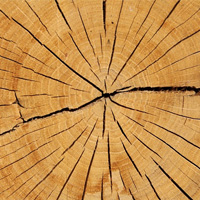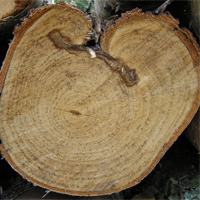The defects in timber are caused by the nature of the soil on which the tree is grown, the fertility it gained, and changes occurred in the environment during its growth.
Defects are hideous and weaken the timber. Timber with defects is much cheaper than the timber without any defects.
The commonly referred defects to be looked into while selecting timber for woodwork are the following:
Knots in Timber
These are the sections of the branches of the tree present on the surface of the wood which appears in the form of hard and dark pieces. Knots are the spots of weaknesses in timber when used to carry compression.
They are called nail knots when the diameter is less than 6 mm; it is called a small knot when it is 6 - 20 mm, it is called a medium knot when it is 20 - 40 mm, it is called a large knot when the diameter is more than 40 mm.

Tight knots are those which are joined securely to the adjacent wood. A knot that is not held firmly in the wood is known as a dead knot or a loose knot. A knot that is free from decay, defects and also intact with the surrounding wood is said to be a live knot or a sound knot.
Timber with large and loose knots should be rejected as they are weak in strength and poor in appearance. All knots in timber used for buildings should be covered with two films of shellac before the wood is painted.
Shakes in Timber
These are cracks and splits found in felled trees due to many causes. Different kinds of shakes are identified such as cup shake, heart shake, star shake, etc.
Heart shakes occurs in over- matured trees with more width at the centre and diminishes towards the edge.

Cup shakes are formed by the rupture of the tissues in a circular direction across the annual rings.
Star shakes are caused mostly due to severe frost or more heat which are confined to sapwood only.
Radial shakes are caused when there is a delay in sawing after felling and radiate to a small distance from the bark towards the centre.
Upset or Rupture
Rupture is caused due to some injury during the growth of the tree due to strong winds or faulty felling of the tree.
Twisted Fibres in Timber
This defect is caused in the tree itself due to the fast-blowing winds. These are also known as twisted grains or wandering hearts. The grains of the wood are twisted in one direction only which causes problems while sawing and can be used as poles or posts.
Presence of Sapwood
Sapwood is less durable than the heartwood, and hence it should be avoided in wood used in important places. As compared, it does not take as good polish as heartwood and can be identified by the colour which will be much lighter than that of heartwood.
Rind Galls
Rind means bark, and gall implies abnormal growth. These are peculiar curved swellings appear on the body of a tree. These rind galls are caused due to the growth of layers over the wounds left over after abnormal felling of trees which makes them weak and not durable.

Wind Cracks
The exterior surface of a tree shrinks when it is exposed to atmospheric agencies results in cracks known as wind cracks. A long thin crack is called a steak.

Wane
Wane is the part of the outside rounded surface of a tree that remains in the timber during conversion. It is considered when the timber is used only for significant woodworks, not for works like shoring, piling, etc.
Sloping grains
In living trees, the cells do not always grow perfectly vertical and parallel to the length of the truck, but in a slopping manner. The taper from bottom to the top causes the grains to slope when the timber is sawn parallel to the pitch. This type of sloping grains is considered as a defect.
Fissures, Resin pockets
Fissures are fibre disruptions which appear in timber due to many causes. Resin pockets and fissures containing resins are defects which affect the strength of timber and suitability for the decoration of the wood.
There may be some other defects that occur during the process of seasoning other than the natural causes, which is also considered while selecting timber for building construction works.
Also Read: Tips for Buying Wooden Products

















